The Tunneling Equipment Market is estimated to be valued at USD 8.6 billion in 2025 and is projected to reach USD 14.0 billion by 2035, registering a compound annual growth rate (CAGR) of 5.0% over the forecast period. Between 2025 and 2030, the market is expected to rise from USD 8.6 billion to USD 11 billion, driven by increasing infrastructure development, urbanization, and demand for efficient tunneling solutions in transportation and utility projects. Year-on-year analysis shows steady growth, with values reaching USD 9 billion in 2026 and USD 9.5 billion in 2027, supported by rising investments in large-scale tunneling projects and improved technologies for underground construction.
By 2028, the market is forecasted to hit USD 10 billion, advancing to USD 10.5 billion in 2029 and USD 11 billion by 2030. Growth will be further fueled by innovations in tunnel boring machines (TBMs), automation, and digitalization of tunneling processes, as well as the increasing use of tunneling equipment for renewable energy infrastructure projects. These dynamics position the tunneling equipment market as a critical segment in the global construction industry, offering opportunities for technological advancements and market expansion in the coming years.
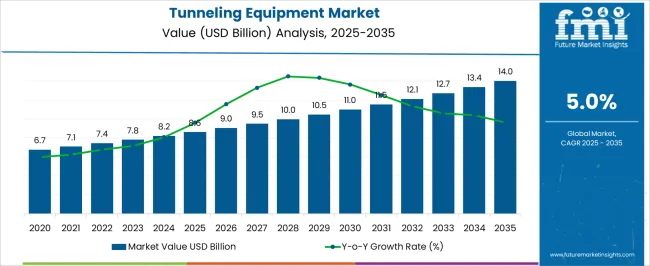
| Metric | Value |
|---|---|
| Tunneling Equipment Market Estimated Value in (2025 E) | USD 8.6 billion |
| Tunneling Equipment Market Forecast Value in (2035 F) | USD 14.0 billion |
| Forecast CAGR (2025 to 2035) | 5.0% |
The tunneling equipment market is experiencing sustained momentum, supported by increasing infrastructure development projects, urban expansion, and demand for efficient sub-surface construction solutions. Rapid urbanization and the rising need for decongested transportation routes have accelerated the deployment of tunneling systems in metro, railway, and utility infrastructure.
Governments and private developers across emerging and developed economies are investing heavily in underground networks to address spatial constraints and sustainability concerns, further amplifying the need for advanced tunneling solutions. The market is being positively influenced by engineering breakthroughs in equipment automation, ground stability analytics, and modular machine design, enabling faster and safer tunneling in varied geological conditions.
The integration of IoT, AI-based machine guidance, and predictive maintenance capabilities into modern tunneling equipment is contributing to greater operational efficiency and cost optimization As nations increase investments in resilient infrastructure and smart city planning, the tunneling equipment market is expected to witness broader adoption across both civil and mining domains.
The tunneling equipment market is segmented by equipment type, application sector, operation type, technology, end-user industry, and geographic regions. By equipment type, the tunneling equipment market is divided into Tunnel Boring Machines (TBM), Shield Tunneling Machines, Roadheader Machines, Microtunneling Machines, and Augers. In terms of the application sector, the tunneling equipment market is classified into Transportation Infrastructure, Water and Sewage Management, Mining Operations, Telecommunication and Electrical Networks, and Hydropower Projects.
Based on the operation type, the tunneling equipment market is segmented into Automated Operation, Manual Operation, and Hybrid Operation. By technology, the tunneling equipment market is segmented into Advanced Tunneling Technology, Conventional Tunneling Technology, Robot-Assisted Tunneling Technology, and Smart Tunneling Solutions. By end-user industry, the tunneling equipment market is segmented into Construction, Mining, Utilities, Transport and Logistics, and Energy and Power. Regionally, the tunneling equipment industry is classified into North America, Latin America, Western Europe, Eastern Europe, Balkan & Baltic Countries, Russia & Belarus, Central Asia, East Asia, South Asia & Pacific, and the Middle East & Africa.
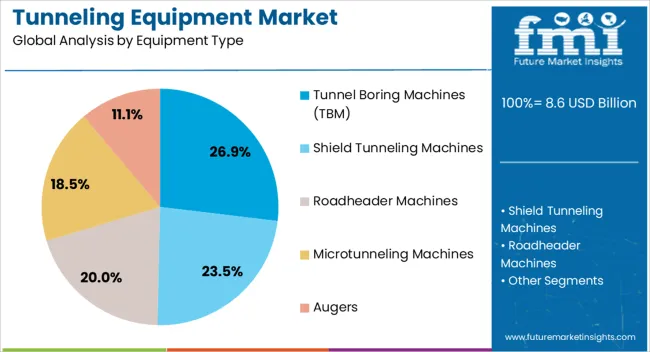
Tunnel boring machines are projected to account for 26.9% of the total tunneling equipment market revenue in 2025, making them a leading equipment type. Their growing adoption has been driven by the ability to deliver continuous excavation with minimal surface disruption, which is particularly critical in densely populated urban areas.
TBMs have become central to large-scale tunnel projects due to their efficiency, structural precision, and enhanced worker safety. Their integration with geotechnical data systems and automated control platforms has improved adaptability to different soil and rock conditions, reducing downtime and ensuring consistent performance.
The high reusability of TBMs for multiple projects, coupled with the reduced need for extensive manual labor, has contributed to long-term cost benefits. With ongoing innovation in cutterhead design, real-time navigation, and machine health monitoring, TBMs are playing a vital role in shaping modern tunnel engineering practices and remain a preferred choice in complex transportation and utility infrastructure projects.

The transportation infrastructure segment is expected to contribute 28.7% to the overall tunneling equipment market revenue in 2025, reflecting its status as the dominant application area. The rise in metro rail expansions, highway underpasses, and cross-border rail corridors has led to heightened demand for tunneling solutions capable of operating under congested environments with minimal disruption.
Transportation infrastructure projects often require extensive underground work, where precision, safety, and speed are critical, making advanced tunneling equipment indispensable. The segment's growth is being supported by increased public and private funding toward improving urban mobility and reducing traffic congestion.
Innovations in tunneling techniques, combined with increased environmental scrutiny, have led to the use of highly specialized equipment that minimizes surface-level environmental and social impacts. As transportation networks modernize and extend into subterranean zones, the role of tunneling equipment in ensuring timely, cost-effective, and environmentally compliant project delivery continues to expand.
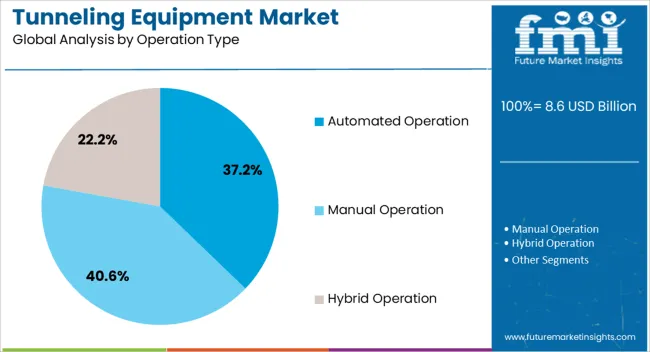
Automated operation is forecast to represent 37.2% of the tunneling equipment market revenue in 2025, establishing it as the leading operational approach. The rising emphasis on operational safety, precision, and cost control has accelerated the shift toward automation in tunnel construction. Automated tunneling equipment leverages advanced control systems, real-time monitoring, and predictive diagnostics to enhance performance in high-risk underground environments.
This operational mode reduces dependency on manual intervention, thereby minimizing human exposure to hazardous conditions and improving overall efficiency. Increased project complexity and the need for around-the-clock operations have further reinforced the adoption of automation technologies.
The integration of autonomous navigation, sensor fusion, and AI-driven analytics has allowed machines to respond dynamically to geological variances without delays. As labor shortages and cost pressures continue to challenge the construction industry, automated tunneling systems are being recognized as a sustainable solution for long-term infrastructure delivery across both developed and emerging economies.
The tunneling equipment market is driven by infrastructure investments and urbanization, with significant opportunities emerging in developing regions. Trends in automation and environmentally friendly solutions continue to reshape the market. However, high initial costs and regulatory constraints present challenges. By 2025, addressing these challenges while capitalizing on opportunities in emerging markets will be key to sustained growth and innovation in the tunneling equipment market.
The tunneling equipment market is expanding rapidly, primarily due to significant investments in infrastructure projects, including transportation systems, water management, and utilities. The rising demand for underground construction solutions, driven by factors such as the need for expanded urban infrastructure and transportation networks, is fueling market growth. By 2025, these developments are expected to continue driving the demand for advanced tunneling equipment, as both public and private sectors invest in critical infrastructure for sustainable urban growth and modernization.
The tunneling equipment market is experiencing notable growth opportunities in emerging markets, where urbanization is rapidly expanding. Infrastructure development in countries like China, India, and Brazil is creating a demand for efficient tunneling solutions for subways, utilities, and mining operations. In addition, projects in regions like the Middle East are contributing to demand, particularly for transportation tunnels and water pipelines. By 2025, these markets are expected to present significant opportunities for tunneling equipment manufacturers, particularly in rapidly developing urban environments.
Emerging trends in the tunneling equipment market include increased automation and the incorporation of green technologies. Automated systems are enhancing operational efficiency, reducing human intervention, and improving safety standards. Furthermore, there is a rising demand for eco-friendly tunneling solutions that minimize environmental impact, including the use of low-emission machines and sustainable tunneling techniques. By 2025, these trends will continue shaping the market, driving innovations in equipment that balances operational efficiency with environmental concerns.
The tunneling equipment market faces challenges related to high initial costs and stringent regulatory constraints. The purchase, installation, and maintenance of tunneling equipment require significant capital investment, which may limit market access for smaller players. Additionally, increasing safety and environmental regulations in various regions present challenges, requiring manufacturers to invest in compliance measures. By 2025, overcoming these barriers will require strategies that focus on cost-effective solutions, while ensuring compliance with local regulations and standards.
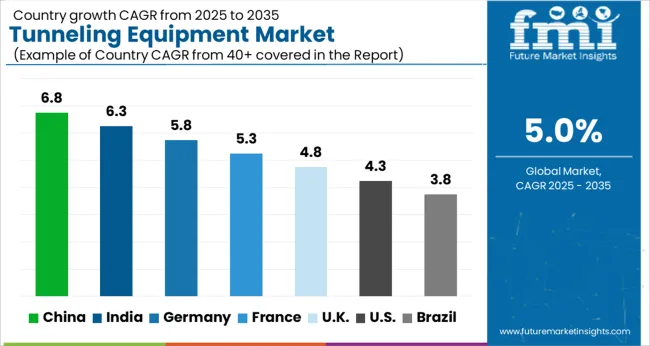
| Countries | CAGR |
|---|---|
| China | 6.8% |
| India | 6.3% |
| Germany | 5.8% |
| France | 5.3% |
| UK | 4.8% |
| USA | 4.3% |
| Brazil | 3.8% |
The global tunneling equipment market is projected to grow at a 5% CAGR from 2025 to 2035. China leads with a growth rate of 6.8%, followed by India at 6.3%, and France at 5.3%. The United Kingdom records a growth rate of 4.8%, while the United States shows the slowest growth at 4.3%. These varying growth rates are driven by increasing demand for tunneling solutions in infrastructure projects, urbanization, and the need for efficient transportation networks. Emerging markets like China and India are experiencing higher growth due to rapid industrialization, large-scale infrastructure projects, and government investments in urban development, while more mature markets like the USA and the UK see steady growth driven by technological advancements, sustainability regulations, and the increasing focus on underground infrastructure solutions. This report includes insights on 40+ countries; the top markets are shown here for reference.
The tunneling equipment market in China is growing rapidly, with a projected CAGR of 6.8%. China’s significant investments in infrastructure development, particularly in transportation networks such as subways, tunnels, and highways, are key drivers of market growth. The country's increasing demand for efficient and sustainable tunneling solutions, coupled with urbanization and industrial expansion, continues to accelerate the adoption of tunneling equipment. Additionally, China’s focus on improving its environmental impact and reducing construction costs fuels the demand for advanced tunneling machinery. Government policies supporting large-scale infrastructure projects and sustainable urban development further boost market growth.
The tunneling equipment market in India is projected to grow at a CAGR of 6.3%. India’s increasing infrastructure development, particularly in urban transport systems, is driving the demand for advanced tunneling equipment. The country’s growing focus on smart cities, road networks, and metro projects continues to contribute to market expansion. Additionally, India’s investments in industrialization and government initiatives to improve urban infrastructure further accelerate the adoption of tunneling machinery. The rising focus on sustainability, reducing environmental impact, and lowering construction costs also supports the growth of tunneling equipment in India.
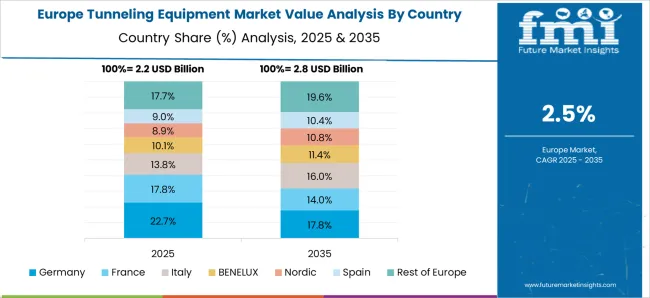
The tunneling equipment market in France is projected to grow at a CAGR of 5.3%. France’s demand for tunneling solutions is driven by the country’s increasing investments in infrastructure projects, particularly in transportation and utilities. The focus on sustainability, including minimizing construction impact on the environment, continues to boost the demand for advanced tunneling machinery. France’s growing metro networks, subways, and underground infrastructure projects further contribute to market expansion. Regulatory frameworks supporting green construction practices and the need for more efficient tunneling operations continue to support the adoption of tunneling equipment in the country.
The tunneling equipment market in the United Kingdom is projected to grow at a CAGR of 4.8%. The UK’s growing infrastructure projects, particularly in the transportation sector, continue to drive steady demand for tunneling equipment. The country’s increasing focus on urbanization and the need for efficient underground infrastructure solutions, including tunnels for transport and utilities, contribute to the market’s growth. Additionally, the UK’s strong regulatory framework promoting sustainability and eco-friendly solutions in construction further accelerates the adoption of advanced tunneling machinery. The rise in government investments in underground infrastructure and metro systems supports market expansion.
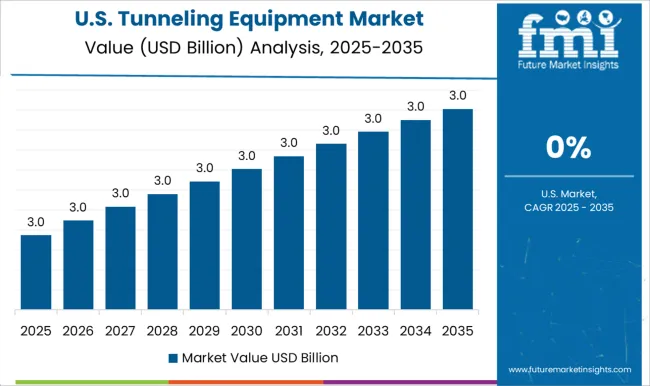
The tunneling equipment market in the United States is expected to grow at a CAGR of 4.3%. The USA market remains steady, driven by increasing demand for underground infrastructure solutions, particularly in urban transport systems and utilities. The country’s focus on improving transportation networks, along with rising investments in sustainable infrastructure, continues to support market growth. The growing need for efficient tunneling solutions in large-scale construction projects, such as subways, highways, and underground facilities, further accelerates the demand for tunneling equipment. The USA government’s push for sustainable urban development and green construction practices further supports market adoption.
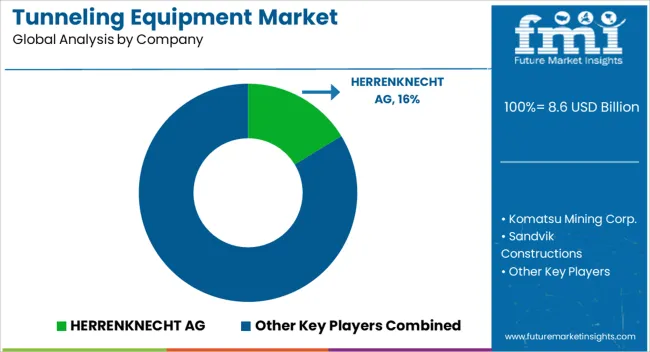
The tunneling equipment market is dominated by HERRENKNECHT AG, which leads with its advanced tunneling machines designed for large-scale infrastructure projects such as metro systems, water tunnels, and underground utilities. HERRENKNECHT’s dominance is supported by its cutting-edge technology, strong market presence, and expertise in providing reliable, efficient solutions for tunneling in challenging geological conditions. Key players such as Komatsu Mining Corp., Sandvik Constructions, and Atlas Copco maintain significant market shares by offering a wide range of tunneling equipment, including tunnel boring machines (TBMs), rock drills, and support systems that improve productivity and safety in tunnel construction. These companies focus on enhancing equipment performance, reducing downtime, and offering tailored solutions for various tunneling needs.
Emerging players like SANYHE International Holdings, Aker Wirth, and Bessac are expanding their market presence by offering specialized tunneling equipment for niche applications, including water and gas pipelines, rail tunnels, and highway construction. Their strategies include improving machine versatility, enhancing safety features, and focusing on sustainable and energy-efficient equipment to meet the growing demand for infrastructure development. Market growth is driven by the increasing global demand for urbanization, transportation networks, and underground infrastructure. Innovations in automation, remote monitoring, and eco-friendly tunneling solutions are expected to continue shaping competitive dynamics and fuel further growth in the global tunneling equipment market.
| Item | Value |
|---|---|
| Quantitative Units | USD 8.6 Billion |
| Equipment Type | Tunnel Boring Machines (TBM), Shield Tunneling Machines, Roadheader Machines, Microtunneling Machines, and Augers |
| Application Sector | Transportation Infrastructure, Water and Sewage Management, Mining Operations, Telecommunication and Electrical Networks, and Hydropower Projects |
| Operation Type | Automated Operation, Manual Operation, and Hybrid Operation |
| Technology | Advanced Tunneling Technology, Conventional Tunneling Technology, Robot-Assisted Tunneling Technology, and Smart Tunneling Solutions |
| End-User Industry | Construction, Mining, Utilities, Transport and Logistics, and Energy and Power |
| Regions Covered | North America, Europe, Asia-Pacific, Latin America, Middle East & Africa |
| Country Covered | United States, Canada, Germany, France, United Kingdom, China, Japan, India, Brazil, South Africa |
| Key Companies Profiled | HERRENKNECHT AG, Komatsu Mining Corp., Sandvik Constructions, Mitsubishi Heavy Industries, Atlas Copco, Hitachi Zosen, SANYHE International Holdings, CREG, Aker Wirth, and Bessac |
| Additional Attributes | Dollar sales by equipment type and application, demand dynamics across transportation, utilities, and mining sectors, regional trends in tunneling equipment adoption, innovation in automation and energy-efficient technologies, impact of regulatory standards on safety and environmental compliance, and emerging use cases in smart infrastructure and urban development projects. |
The global tunneling equipment market is estimated to be valued at USD 8.6 billion in 2025.
The market size for the tunneling equipment market is projected to reach USD 14.0 billion by 2035.
The tunneling equipment market is expected to grow at a 5.0% CAGR between 2025 and 2035.
The key product types in tunneling equipment market are tunnel boring machines (tbm), shield tunneling machines, roadheader machines, microtunneling machines and augers.
In terms of application sector, transportation infrastructure segment to command 28.7% share in the tunneling equipment market in 2025.






Our Research Products

The "Full Research Suite" delivers actionable market intel, deep dives on markets or technologies, so clients act faster, cut risk, and unlock growth.

The Leaderboard benchmarks and ranks top vendors, classifying them as Established Leaders, Leading Challengers, or Disruptors & Challengers.

Locates where complements amplify value and substitutes erode it, forecasting net impact by horizon

We deliver granular, decision-grade intel: market sizing, 5-year forecasts, pricing, adoption, usage, revenue, and operational KPIs—plus competitor tracking, regulation, and value chains—across 60 countries broadly.

Spot the shifts before they hit your P&L. We track inflection points, adoption curves, pricing moves, and ecosystem plays to show where demand is heading, why it is changing, and what to do next across high-growth markets and disruptive tech

Real-time reads of user behavior. We track shifting priorities, perceptions of today’s and next-gen services, and provider experience, then pace how fast tech moves from trial to adoption, blending buyer, consumer, and channel inputs with social signals (#WhySwitch, #UX).

Partner with our analyst team to build a custom report designed around your business priorities. From analysing market trends to assessing competitors or crafting bespoke datasets, we tailor insights to your needs.
Supplier Intelligence
Discovery & Profiling
Capacity & Footprint
Performance & Risk
Compliance & Governance
Commercial Readiness
Who Supplies Whom
Scorecards & Shortlists
Playbooks & Docs
Category Intelligence
Definition & Scope
Demand & Use Cases
Cost Drivers
Market Structure
Supply Chain Map
Trade & Policy
Operating Norms
Deliverables
Buyer Intelligence
Account Basics
Spend & Scope
Procurement Model
Vendor Requirements
Terms & Policies
Entry Strategy
Pain Points & Triggers
Outputs
Pricing Analysis
Benchmarks
Trends
Should-Cost
Indexation
Landed Cost
Commercial Terms
Deliverables
Brand Analysis
Positioning & Value Prop
Share & Presence
Customer Evidence
Go-to-Market
Digital & Reputation
Compliance & Trust
KPIs & Gaps
Outputs
Full Research Suite comprises of:
Market outlook & trends analysis
Interviews & case studies
Strategic recommendations
Vendor profiles & capabilities analysis
5-year forecasts
8 regions and 60+ country-level data splits
Market segment data splits
12 months of continuous data updates
DELIVERED AS:
PDF EXCEL ONLINE
Equipment Management Software Market Size and Share Forecast Outlook 2025 to 2035
Equipment cases market Size and Share Forecast Outlook 2025 to 2035
Farm Equipment Market Forecast and Outlook 2025 to 2035
Golf Equipment Market Size and Share Forecast Outlook 2025 to 2035
Port Equipment Market Size and Share Forecast Outlook 2025 to 2035
Pouch Equipment Market Growth – Demand, Trends & Outlook 2025 to 2035
Garage Equipment Market Forecast and Outlook 2025 to 2035
Mining Equipment Industry Analysis in Latin America Size and Share Forecast Outlook 2025 to 2035
Subsea Equipment Market Size and Share Forecast Outlook 2025 to 2035
Pavers Equipment Market Size and Share Forecast Outlook 2025 to 2035
Tennis Equipment Market Analysis - Size, Share, and Forecast Outlook 2025 to 2035
Galley Equipment Market Analysis and Forecast by Fit, Application, and Region through 2035
Sorting Equipment Market Size and Share Forecast Outlook 2025 to 2035
General Equipment Rental Services Market Size and Share Forecast Outlook 2025 to 2035
Bagging Equipment Market Size and Share Forecast Outlook 2025 to 2035
RF Test Equipment Market Size and Share Forecast Outlook 2025 to 2035
Medical Equipment Covers Market Size and Share Forecast Outlook 2025 to 2035
Telecom Equipment Market Size and Share Forecast Outlook 2025 to 2035
Welding Equipment And Consumables Market Size and Share Forecast Outlook 2025 to 2035
Hunting Equipment and Accessory Market Analysis - Size, Share, and Forecast Outlook 2025 to 2035

Thank you!
You will receive an email from our Business Development Manager. Please be sure to check your SPAM/JUNK folder too.
Chat With
MaRIA